You're likely not off the reservation, its probably me. I agree that surface hoar is going to be a hudge problem in the upcoming days with WFO Boulder saying that we could experience some of the coldest temps in FORTY YEARs.
I always thought that large temperature gradients in the snowpack added facet growth, but I could be way off base...
Woolbury commented to me that in Floral Park the other day he dug a pit to the ground and saw TWO feet of facets at the bottom of the pack.
Results 301 to 325 of 481
-
01-14-2008, 01:34 PM #301
-
01-14-2008, 02:09 PM #302
i hesitate to comment here because i really have very little experience in comparison to the other posters here, but it seems like the reservation is somewhere in between both sides and on both sides at the same time.
We've got a super variable snowpack and snowdepth with our crazy wind event from not so long ago. We've got deep and we've got shallow.
It would seem to stand that the deep pockets already have the 2ft'ish depth hoar fromo the ground from early season snow that was left around when that one cold snap came through a couple weeks ago. I also wouldnt think DH development would change that much in these deeper pockets as whats done is done and the deeper pack helps to insulate against this new colder weather. I havent gotten out there and measured snow pack temperature profiles, so I really dont know. Maybe we'll get some hoar and facet development in the middle layers of the pack?
On the thinner spots on the western half of the compass, id think that we might see a similar scenario to what happend to the deep pockets just a couple weeks ago. Possibilities of full depth hoar.
in a nutshell, super variable sketchy colorado snow pack.
beware and dig.
-
01-14-2008, 02:13 PM #303
-
01-14-2008, 02:13 PM #304
1 deep pit from yesterday for what little it is worth as a single data point...
below treeline, just below 11K NE facing, very open trees ~30deg, ~2mi N of two elk pass
250-220 F
220-165 4F
165-135 1F
135-95 P
95-40 P-K-P
40-0 1F-P (medium sized facets with some cohesion)
2xSCT H5 Q2 @ 135Last edited by Summit; 01-14-2008 at 02:18 PM.
 Originally Posted by blurred
Originally Posted by blurred
-
01-14-2008, 02:17 PM #305
summit, which box of cereal do I need to buy to have the right decoder ring to understand that

-
01-14-2008, 02:20 PM #306"It is not the result that counts! It is not the result but the spirit! Not what - but how. Not what has been attained - but at what price.
- A. Solzhenitsyn
-
01-14-2008, 02:34 PM #307
A little more analysis from the previous fatality. Some scary quotes in there.
The three men — a skier and two snowboarders — carried beacons, shovels and probes. Two of them had taken avalanche safety classes, Toepfer said.
“They knew the avalanche rating,” said Don Dressler of the Forest Service. “They had the equipment. They followed the one-at-a-time rules.”
The men did tests — so-called “ski cuts” and “stomp” tests — at the top of the chute to assess its safety, Toepfer said.
In fact, one of those tests triggered a smaller avalanche, about 1 foot deep, that exposed the slope to a substantial amount of weight, Toepfer said.
“Far more weight than you, me, my son, my dog going down the slope at the same time,” Toepfer said.
That was a factor in their decision to ski the chute, Toepfer said.
The men didn’t dig a snow pit to do compaction tests, Toepfer said. The top of the slope was exposed and the men would have been in danger, he said.
Brigham was the last of the three to ride the chute. He was two turns into the chute when it slid.
The avalanche slid on a very small, weak layer about 7 feet deep in the snowpack, Toepfer said. The weak layer was just 1 millimeter thick, he said.
“This layer, if you were out there studying (the snowpack), you’d probably never find it,” Toepfer said.Is it radix panax notoginseng? - splat
This is like hanging yourself but the rope breaks. - DTM
Dude Listen to mtm. He's a marriage counselor at burning man. - subtle plague
-
01-14-2008, 08:00 PM #308
hudge surface hoar feathers at Ptarmigan Pass today
I didn't believe in reincarnation when I was your age either.
-
01-14-2008, 11:04 PM #309
Here's a pit that we dug a few miles from the summit of Buffalo pass on the western side on a WNW aspect on about a 27 degree pitch. This was on Sunday. The forecast for the Steamboat area was considerable however the pit showed good stability. I also found the area to be much more consistent then summit/vail where there had been massive wind loading.
Here's what my buddy wrote the CAIC regarding information observed from the pit.
--
After studying your reports we decided that our best bet was to head to the boat and investigate this new 3-4 ft. It was truly epic. I have attached a picture of our pit and the failures I observed. I would say most of what you posted was pretty accurate. We dug about 10-11 feet deep to reach the bottom. The poke test didn’t give too many clues but it was apparent that as you moved deeper the snow was much more consolidated than the really light snow on top. About 4 feet into the pack was an apparent hard icey layer that had pine needles in it (this layer did not fail during the testing). About 5 inches above this icey layer and 4 inches about that did fail at level 6. Of note was that the hoar layer in this spot was not as bad as I was expecting. It was about 3 inches in depth and seemed to most resemble this crystal formation: http://www.lpsi.barc.usda.gov/emusnow/comparison/10.jpg a longer hexagonal crystal.
--

Last edited by jSki; 01-14-2008 at 11:19 PM.
-
01-15-2008, 12:53 PM #310
 Registered User
Registered User
- Join Date
- Dec 2007
- Posts
- 9
-
01-15-2008, 02:57 PM #311Is it radix panax notoginseng? - splat
This is like hanging yourself but the rope breaks. - DTM
Dude Listen to mtm. He's a marriage counselor at burning man. - subtle plague
-
01-15-2008, 09:53 PM #312
story about Matt Gustafson, who died at EV on Saturday, in the Vail Daily
http://www.vaildaily.com/article/20080115/NEWS/96196623
Matthew Gustafson, who died Saturday in an avalanche in an East Vail chute, stands at the top of a backcountry run three years ago in the same area.
Matthew Gustafson sails off a cornice in East Vail. Gustafson, 33, of Vail, died Saturday in an avalanche in the same area.
A memorial service for Matthew Gustafson will be held at Vail Interfaith Chapel, 19 Vail Rd., Thursday at 3 p.m. A reception will follow at Garfinkels.I didn't believe in reincarnation when I was your age either.
-
01-17-2008, 02:42 AM #313
Tuesday encountered medium and smaller surface hoar ~12 miles WNW of that location... found on most aspects near and below... however I noted that by the end of the day, most aspects below treeline had experienced heating that destroyed or greatly shrank the surface hoar. Unfortunately, sun exposed aspects had developed a very thin sun crust by sunset.
 Originally Posted by blurred
Originally Posted by blurred
-
01-19-2008, 10:20 PM #314
Went out today for the first time in a while. Thought I would share this:
The circled tree is about 50-75 years old. It's roughly 250 feet away from and 75 feet above the Slate River. And at some point during the massive early January storm, the "Climax chutes", as they are known, ripped out and took the tree with it. It's not a great photo, but you get the idea. I guess that's what happens when 4 or 5 feet fall in 3 days.
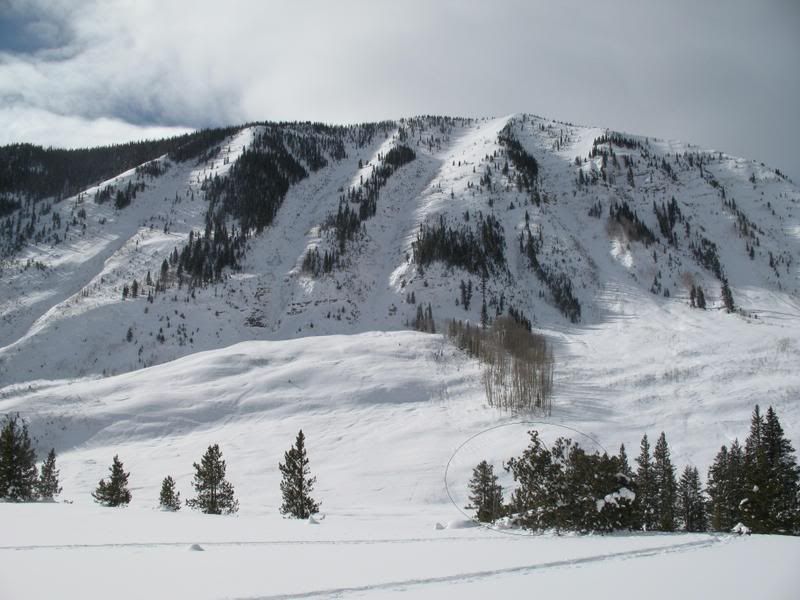
-
01-21-2008, 12:40 AM #315
 Registered User
Registered User
- Join Date
- Nov 2005
- Posts
- 528
thanks guys.
this discusion has been extremly helpfull to me.
I too, will start posting my observations, in a latter less wasted state. but as a longtimme lurker...I thank you.\
holla at your boy when you see him eatin a hot dog in DA STREET.
-
01-21-2008, 01:52 PM #316
CAIC has a good read on a close call in December in the East Vail area
-
01-27-2008, 01:54 AM #317
made a few turns today at vail pass
Poking around in the snow all day didnt reveal a whole lot to be honest.
The top 2 layers, one being the new snow and the other the snow before that felt the softest when punching through until you hit consolidated snow all the way i can reach with my pole without bending over. Felt confident in the snow but the forecast i had just heard and the history so far this season still didnt set well.
so we decided to dig a hasty pit to isolate a few columns just to see whats happened with all this new snow
~11,700 ft - near but below treeline
SW Facing slope / 25*
looking at the pit wall and looking for weak layers it just wasnt obvious that there were any. The whole thing , besides the new snow, was 1-4 finger. I was generally shocked to see such well consolidated snow without any prominent weak layers.
Our compression tests revealed 2 weak layers at ~25 and 30cm (if im remembering correctly) The weak layers, which were extremely thin, were sitting between 2 cohesive slabs with Q1 shears. Really not very confidence inspiring given that they failed simultaneously around 8 wrist taps. Id say the only way to really have found these weak layers on examination of the wall was with a credit card or something similar. Doing some quick hand pits on the way up would have definitely revealed them as well.
We didnt dig deeper than about 4 ft which was all consolidated. Surprised not to see facets even if we only dug 4ft.
overall, not at all confidence inspiring on the snowpack.
on a sidenote
was that you telemike that I was talking to?
i had the white helmet, red jacket, goatee, and 183bros. (had my gf and my buddy with me)
figured youd have said something being i had those skis.Last edited by pechelman; 01-27-2008 at 08:25 PM.
-
01-27-2008, 06:40 PM #318
yep - that were me - should have asked about the Bro's
Your assessment is about what I've been seeing too. There are facets down on the ground - a whole bunch of them. I've not been having glaringly spooky test results, but it seems like every day or two we see something new slide in some random place or other.
I too, have very little confidence in the snowpack, and am making conservative terrain choices.
I was out Corral Creek to Uneva Pass today. Very good turns.
oh, yeah....almost forgot.....
AVALANCHE WATCH
COLORADO AVALANCHE INFORMATION CENTER
RELAYED BY NATIONAL WEATHER SERVICE DENVER/BOULDER CO
807 AM MST SUN JAN 27 2008
THE FOLLOWING MESSAGE IS TRANSMITTED AT THE REQUEST OF THE
COLORADO AVALANCHE INFORMATION CENTER.
...AVALANCHE WATCH BULLETIN FOR THE SAN JUANS...GRAND MESA...WEST
ELK...ELK...AND SAWATCH MOUNTAINS OF SOUTHERN AND CENTRAL COLORADO...
THE COLORADO AVALANCHE INFORMATION CENTER HAS ISSUED AN AVALANCHE
WATCH FOR THE MOUNTAINS OF SOUTHERN AND CENTRAL COLORADO.
HEAVY SNOW AND STRONG WINDS ARE FORECAST TO BEGIN SUNDAY AFTERNOON.
FORECAST SNOWFALL IS EXPECTED TO EXCEED TWO FEET BY TUESDAY MORNING.
NEW SNOW AND STRONG SOUTHWEST WINDS WILL RAPIDLY LOAD SLOPES OVER
THE NEXT 24 HOURS.
A WATCH MEANS THAT NATURAL AVALANCHES AND HUMAN TRIGGERED AVALANCHES
COULD BECOME LIKELY.
BACKCOUNTRY TRAVELERS SHOULD USE EXTRA CAUTION DURING THE NEXT 24
HOURS IN THESE REGIONS. TRAVEL IN OR BELOW AVALANCHE TERRAIN IS NOT
RECOMMENDED IN THESE AREAS. SAFE BACK COUNTRY TRAVEL WILL REQUIRE
ADVANCED AVALANCHE SKILLS.
THIS WATCH IS VALID THROUGH 8 AM MONDAY MORNING.
THIS STATEMENT IS OF PARTICULAR INTEREST TO PERSONS USING THE
BACKCOUNTRY OUTSIDE DEVELOPED SKI AREA BOUNDARIES. WHEN NECESSARY
SKI AREAS USE AVALANCHE CONTROL METHODS WITHIN THEIR BOUNDARIES.
FOR ADDITIONAL AVALANCHE INFORMATION...CALL...970-482-0457 IN FORT
COLLINS...719-520-0020 IN COLORADO SPRINGS...970-668-0600 IN SUMMIT
COUNTY...719-395-4994 IN BUENA VISTA...970-247-8187 IN
DURANGO...970-920-1664 IN ASPEN...303-275-5360 IN DENVER. OR VISIT
OUR WEB PAGE AT AVALANCHE.STATE.CO.US
LOGAN
COLORADO AVALANCHE INFORMATION CENTER
2007-08 WATCH 8Last edited by ~mikey b; 01-27-2008 at 06:42 PM.
I didn't believe in reincarnation when I was your age either.
-
01-27-2008, 10:20 PM #319
 Hated far and wide
Hated far and wide
- Join Date
- Mar 2007
- Location
- evergreen
- Posts
- 239
Sat. I had some slide activity in the hourglass at BP. On my way down to the entrance I kicked off a 5-10' pocket 4-6 inches deep and nothing else moved so I proceded to the entrance where I got a view of all the hazards (from the top as I had already scoped it from below). decided I was comfortable and dropped in, about 3 turns in it ripped with me in the middle of it all. Luckily only the fresh soft wind slab pulled out 6" deep 15-30' wide.
I str8 lined for the choke as soon as I saw everything get blocky and funneled in with all the snow just trying to stay on my feet and get through the chock with out any hang ups. Got through and out of the way as fast as I could and I was in the clear. At the choke the snow was like white water as it constricted the flow and things seemingly slowed down a bit. At that point the moving snow around me was mid thigh to waist deep, and as I was spit out the other side the snow went a diffrent way than I did.

The aspect was mostly N NE facing and below tree line, pretty steep too(im guessing 40+ish?).
Today we went to tea cup bowl and on the first run we had a soft slab pull out. It was of no suprise as there has been alot of activity on SE facing aspects, there was even signs of natural released small soft wind slab just to the side of the aspect we were planning to be on. Knowing the danger we discussed what might happen if it does rip. We were clear about staying away from "strainers and cheese graters" and having a clean run out just in case. Just as expected it slid and just as planned my buddy had a clean run out. Once the slide stopped we spoke as I could not see him but apparently he was not buried much. His legs were burried about 2 feet deep or less and his pack seemed to give his torso floatation. he came to a stop near the front of the toe.
He was free and moving 3 minutes or less after it stopped.
He had an avy lung and beacon so if he was fully burried the chances of survival were still pretty acceptable to us as I was in my snow shoes not too far away with my shovel and probe out and ready.
The slab ripped 6"-1' on avarage at the crown is our estimate, and I would guess it propogated around 100' wide and had a track of about 100-250'. It was the fresh soft windslab that pulled out and I don't think it stepped down. It also did not run out into the flats but stoped on the lower angle hill above it.
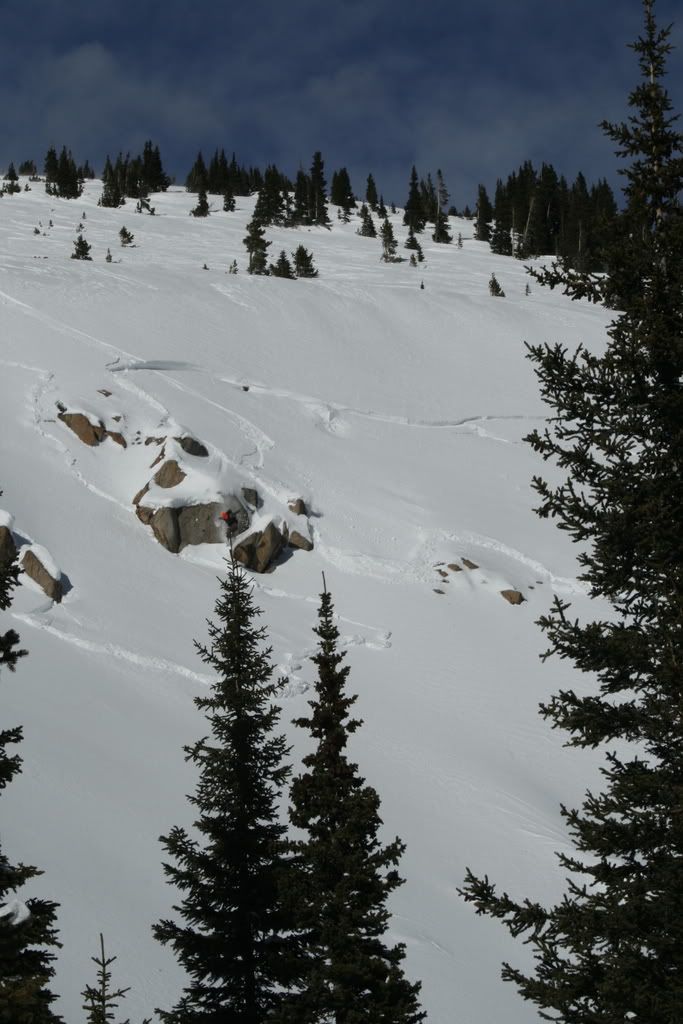
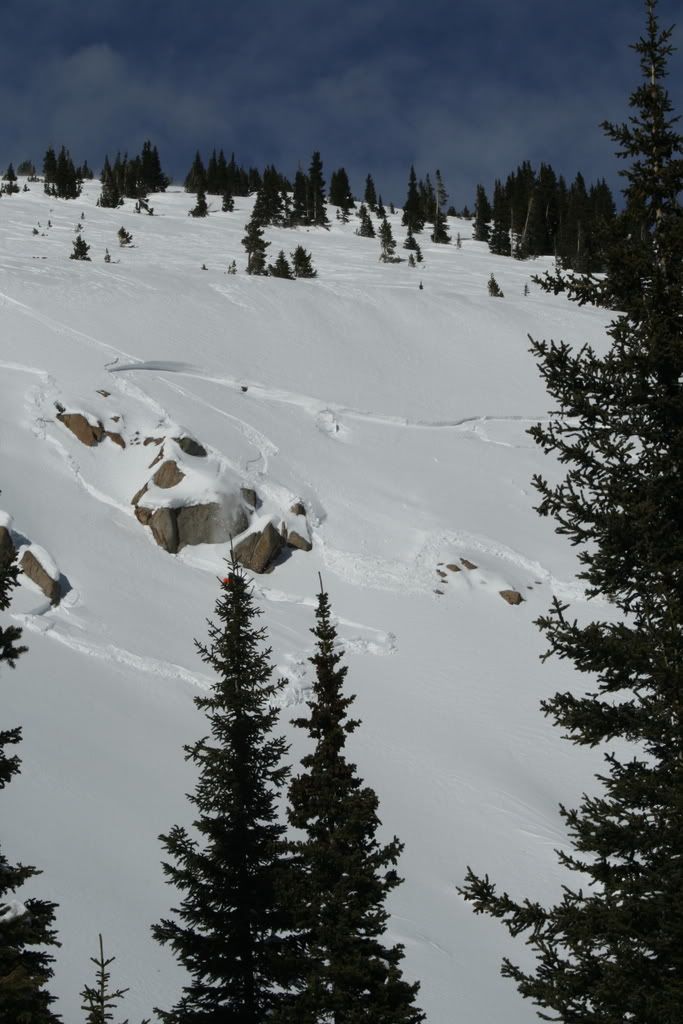


-
01-28-2008, 03:29 PM #320
-
01-29-2008, 09:54 AM #321
 Originally Posted by From Todays Vail\Summit CAIC Forecast
Originally Posted by From Todays Vail\Summit CAIC Forecast
so granted its slightly different aspect and slope angle but I just thought Id point out the similarities to the observations we made and the ones that Party made in K-chute. Just another warning that it might not be so easy to asses stability with the typical surface evaluations especially after this new snow.
be careful in your terrain choices
K would scare the shit out of me right now.
-
01-29-2008, 11:31 AM #322
Monarch Pass 1/26/08, @ ~11,600' on SE facing slope of ~33deg.
Mostly sunny, w/ temps ~ mid 20s F.
6' deep pit: Shovel tests on the snow column yielded no failures on all wrist taps(A1-A5) and elbow blows(B1-B10), but settlement of the top 8"(loose powder of less than fist hardness) was observed. A very slight collapse(Q1) was observed on the first shoulder strike(C1) on a layer approx. 18" down. Snow column withstood subsequent shoulder strikes (C2-C10) without shear failure. Column failed(Q3) on final shovel pry on this weaker layer 18" down. This weaker layer was most likely, buried surface hoar, less than 1/8" thick. The bottom 18" - 70" of the column remained intact even when pryed out with a shovel. The snowpack from 18"-70" down consisted of pencil to one finger hardness snow.
It's very possible that a steeper slope (38+ deg) could have yielded different results with a shear failure (Q3) on the weaker layer.Last edited by cmsummit; 01-29-2008 at 11:38 AM.
Old's Cool.
-
01-29-2008, 12:31 PM #323
IN the vacinity of Rollins Pass closer to Eldora on Sunday 1/27.
SE facing slope. Pit was ~ 4.5' to the ground...fairly wind affected.
Complete column Q3 failure at C2. (no pic) The entire column sheared off the ~1.5' deep base facet layer. (not really surprising)
The pics show multiple Q1/2 shears at B1-B10 on a different column I made to play around with and take a closer look.
You can see the faceted "ball bearing" texture in the second pic after I liftet the first major top slab off the column.
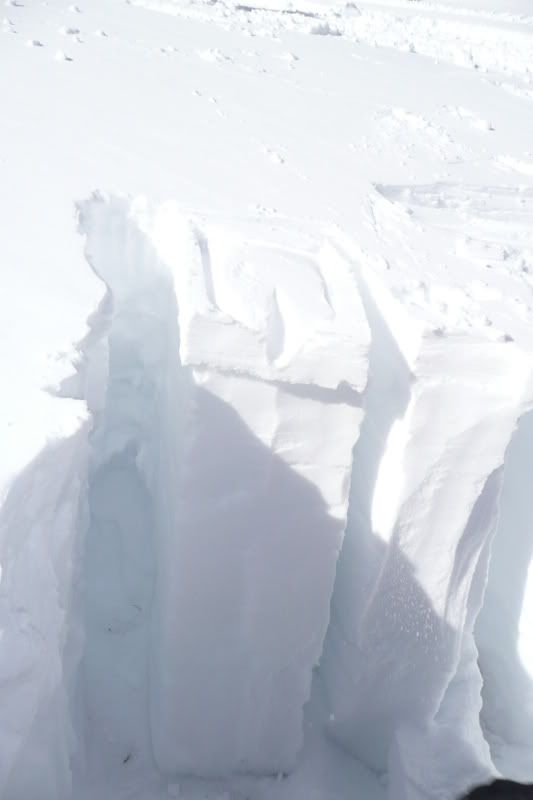

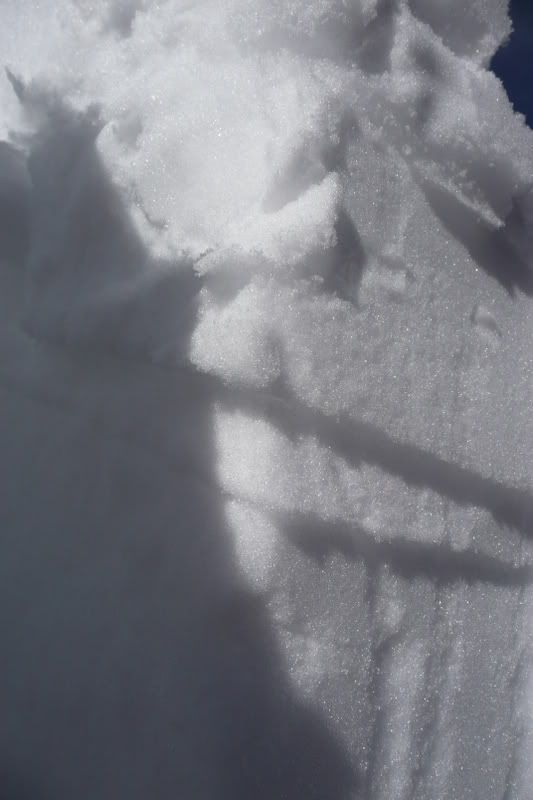
-
02-03-2008, 03:07 PM #324
Berthoud Pass
NW, NE, and North aspects. Blowing pretty hard creating a new windslab layer on top of the existing very hard wind slab. This shallow layer was quite reactive and sluffed on steepish slopes. The wind slab is sitting on top of a very deep layer of junk. Its hard to get things to go, but when they do, they'll go big.
-
02-04-2008, 03:16 PM #325
 Registered User
Registered User
- Join Date
- May 2005
- Posts
- 4,002
Just can't let this whole thread slide by the season without a shot and a tale with the dreaded deadly ALL black avy icon... the one we almost never see... and in the South San Juans of all places.
-------------
From CAIC 2/4/8
 Originally Posted by CAIC
Originally Posted by CAIC
--------------
The CB area sounds like some exciting stuff too.
 Originally Posted by CAIC
Originally Posted by CAIC
Similar Threads
-
Kirkwood Disc Tournament
By Whatever'sClever in forum General Ski / Snowboard DiscussionReplies: 2Last Post: 08-01-2007, 05:51 AM -
TR: Chamonix 4/5-4/6
By jumpturn in forum General Ski / Snowboard DiscussionReplies: 8Last Post: 05-02-2007, 08:14 AM -
Colorado: 2007 Oredigger Classic Road Race
By beast in forum Sprocket RocketsReplies: 7Last Post: 03-31-2007, 09:22 PM -
Would you like thousands to watch your video?
By kaseykolak in forum Tech TalkReplies: 0Last Post: 01-19-2007, 10:52 AM -
Co ski conditions bitchen
By skifasttakechances in forum General Ski / Snowboard DiscussionReplies: 68Last Post: 11-17-2006, 12:36 PM




 Reply With Quote
Reply With Quote




Bookmarks